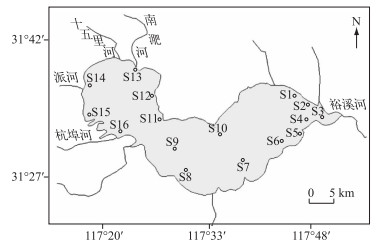(2: 安徽省环境污染防治与生态修复协同创新中心, 合肥 230022)
(3: 中国科学技术大学地球与空间科学学院, 中国科学院壳幔物质与环境重点实验室, 合肥 230026)
(2: Cooperative Innovation Center of Environmental Pollution Prevention and Ecological Rehabilitation in Anhui Province, Hefei 230022, P. R. China)
(3: CAS Key Laboratory of Crust-Material and Environments, School of Earth and Space Sciences, University of Science and Technology of China, Hefei 230026, P. R. China)
多溴联苯醚(简称PBDEs)在环境中具有持久性、生物蓄积性和长距离迁移等特点,对生物和人体产生危害,曾广泛应用于塑料、纺织、电器设备如电视机、电脑等物品的阻燃剂中[1].尽管含PBDEs的商品生产和使用已经被限制,且逐渐被退出全球市场,但近年来,它们仍然在大气、水体、沉积物、土壤、植物、海洋以及人体组织中被检测到[2].有研究表明PBDEs在环境及人体中的含量呈现不断增加的趋势[3].国内学者对PBDEs的研究在2003年开始逐渐兴起,如分别有学者对青岛近岸沉积物、珠江三角洲沉积物以及珠江河口水生生物中PBDEs的含量和分布进行了研究,并在PBDEs的环境分布、迁移和归宿方面取得了一定的研究成果[1, 4-5].
巢湖是我国的五大淡水湖之一,位于安徽省中部区域[6].巢湖水产资源丰富,生态效应极为敏感.近几十年来,随着工农业的快速发展和人口规模的增加,不同污染源的污染物通过土壤径流和大气降水等多种途径进入巢湖水体,使水环境日趋恶化,水生环境受到威胁和破坏[7].目前关于巢湖水体中的研究主要集中在重金属污染和水体富营养化方面,对于PBDEs的研究相对较少,而PBDEs作为环境中持久性有机污染物之一,广泛存在于空气、水体和底泥、土壤等环境介质中[8].由于其较高的亲脂性,进入环境介质中的PBDEs易分配吸附到到生物体和沉积物中,并通过食物链富集,对人类健康和生态环境具有很大的潜在危害[9-10].
1 材料与方法 1.1 样品采集于2015年9月使用抓斗采样器在巢湖西半湖(6个)、湖心(4个)和东半湖(6个)共采集16个表层沉积物(0~5 cm)样品(图 1).采集的样品迅速带回实验室在-20℃温度下储存,直至分析.

|
图 1 巢湖表层沉积物采样点分布 Fig.1 Distribution of the sampling sites in Lake Chaohu |
样品提取前经冷冻干燥48 h、磨碎、过100目筛后保存在深色磨口瓶中.使用索氏抽提法对样品中的目标物进行提取,具体步骤为:精确称量10 g样品放入200 ml烧瓶中,并加入体积比1 :1混合的丙酮-正己烷溶剂、3种13C标记的PBDEs回收率指示物和Cu片(脱硫作用),在45℃水浴锅中抽提48 h.抽提结束后,将烧瓶中的抽提液在旋转蒸发仪上浓缩至1 ml,浓缩液过多层硅胶氧化铝柱净化,净化柱用35 ml正己烷、70 ml的正己烷-二氯甲烷(体积比1 :1)淋洗,淋洗液旋转蒸发浓缩至1 ml, 转入细胞甁中,密闭保存,仪器分析前添加内标物为BDE-71(Accustandard Inc.,USA).
1.3 PBDEs的测定PBDEs的测定采用Aglient 7890气相色谱仪和5975C质谱仪,色谱柱为DB-5MS毛细管柱(30 m×0.25 mm ×0.1 μm).升温程序为:60℃下保留2 min,然后以10℃/min的速率升至200℃并保持2 min,再以20℃/min升到300℃保持10 min. BDE209的测定采用Thermo Trace Ultra气相色谱仪和Thermo DSQ Ⅱ质谱仪分析,色谱柱为DB-5HT毛细管柱(15 m× 0.25 mm× 0.1 μm),升温程序为:起始温度120℃, 保持1 min, 以25℃/min的速度升到330℃, 保持10 min.载气均为高纯氮气,离子源温度为150℃.界面温度280℃.选择离子为79和81.选择离子监测模式(SIM)检测,1 μl不分流进样.
1.4 质量保证与质量控制每分析5个样品做1个加基样品(检测实验方法的可靠性)、1个空白样品(检测实验过程中外界因素是否有干扰)和3个平行样品(检测实验方法的误差).仪器检测限定义为3倍信噪比(S/N),方法检测限范围为0.001~0.004 ng/g, 加基样品的回收率为98.6 % ~106 %;空白样品中均未检测到目标物质的存在,平行样品的相对标准偏差范围为0.3 % ~8.0 %,所有质量保证和质量控制均处于可接受的范围内.
2 结果与讨论 2.1 沉积物中PBDEs含量在研究的39种低溴代PBDEs(LPBDEs)和它们的主要同系物BDE209中,仅检测到BDE35、BDE37、BDE47、BDE99、BDE85、BDE154、BDE153、BDE183和BDE209 9种化合物,其他同系物均未被检测出. ∑LPBDEs的含量为0.001~2.75 ng/g,平均值为1.15 ng/g,平均检测率为44.83 %,BDE209的含量为1.16~5.49 ng/g,平均值为2.83 ng/g,检测率为100 % (表 1).表明这类污染物在巢湖沉积物中有着普遍的分布.在检测到的目标化合物中,BDE209和BDE183的检测率达到100 %.目前还没有关于PBDEs的沉积物标准限值,为了更好地掌握本研究中沉积物的PBDEs污染现状,将研究结果与国内外最近的报道进行比较,结果显示,巢湖表层沉积物中PBDEs的污染大致与国际上报道较清洁的淡水沉积物中的含量(∑PBDEs含量为0.06~3.97 ng/g)处于同一水平[11].
| 表 1 巢湖表层沉积物中LPBDEs及BDE209的含量* Tab.1 Contents of LPBDEs and BDE209 in surface sediments of Lake Chaohu |
将16个采集点按照东半湖(6个点)、西半湖(6个点)、湖心(4个点)进行了分类比较(图 2),结果发现各类LPBDEs和BDE209同系物含量为:西半湖>东半湖>湖心.西半湖沉积物中LPBDEs和BDE209含量较高, 可能是由于西半湖入湖河流较多(如:派河、丙子河、塘西河等),PBDEs随着市政和工业废水的排放进入城市的地表径流,流入巢湖西半湖;而湖心沉积物中LPBDEs和BDE209同系物含量较低可能是由于湖心离入湖的河口较远,污染物随着湖水的稀释和扩散,其中浓度到湖心后大大减小.

|
图 2 巢湖表层沉积物中LPBDEs和BDE209含量的空间分布 Fig.2 Distribution of LPBDEs and BDE209 contents in surface sediments of Lake Chaohu |
与国内其他区域相比,巢湖沉积物中∑LPBDEs的总含量处于中等水平,与中国青岛近岸海域和东海海域沉积物中∑LPBDEs的残留水平基本相当,但高于黄河入海口、莱州湾、长江三角洲和渤海沉积物中∑LPBDEs的残留水平(表 2),可能的原因是黄河入海口、莱州湾等区域生态环境受到政府的保护,外来污染源进入研究区较少,比如:黄河入海口、莱州湾区域早在1980年就被政府授予国家级自然保护区[10].巢湖沉积物中∑LPBDEs的总含量水平远远低于东江、珠江、太湖和珠江口沉积物中∑LPBDEs的残留水平,可能是因为珠江口、江苏等沿海区域工业经济发展快于安徽,含PBDEs的电子产品和塑料产品使用量比安徽更多、使用时间更早.与国外研究区域相比,巢湖沉积物中的∑LPBDEs含量要高于美国的夏厄沃西河和萨吉诺河,但远远低于美国的Hadley湖和荷兰的Scheldt河,这可能与当地经济发展水平相关.另外,本研究区沉积物中的BDE209含量远远低于上述地区的BDE209含量(表 2).由此可知,巢湖沉积物中PBDEs处于较低的污染水平.
| 表 2 与其他地区表层沉积物中LPBDEs和BDE209含量的对比 Tab.2 Comparison of LPBDEs and BDE209 contents in surface sediments of other areas around the world |
本研究调查发现,巢湖沉积物中的PBDEs以BDE209为主,经过计算,BDE209平均含量占PBDEs总量的71.14 %.据相关文献报道[5],BDE209是十溴联苯醚商品的主要成分(成分含量>90 %),我国生产的溴代阻燃剂成分以十溴联苯醚商品为主,关于巢湖沉积物中多溴联苯醚以BDE209为主要成分的研究结果与我国目前使用溴代阻燃剂的现状相吻合,也与现有文献中报道的关于我国沉积物中PBDEs的污染状况一致[11, 13-14].巢湖不同采样点沉积物中LPBDEs的组成明显不同.沉积物中BDE183在16个采样点均检测出,而且在每个采样点所占的比重都较高. BDE183是八溴联苯醚阻燃剂的主要成分,这表明八溴联苯醚阻燃剂在巢湖流域有一定程度的使用. BDE99、BDE47、BDE153、BDE85和BDE154是LPBDEs的主要同系物,也是五溴联苯醚阻燃剂的主要成分,表明它们可能来自五溴联苯醚阻燃剂.这些化合物在不同采样点均有不同程度检测出,尤其是BDE153的检测率达到81.25 %,只在湖心3个点(S8、S9和S10)未检测出(图 3).

|
图 3 巢湖表层沉积物中LPBDEs的组成 Fig.3 Composition of LPBDEs in surface sediments of Lake Chaohu |
不同采样点PBDEs同系物的组成不同,可能与巢湖流域PBDEs的来源有关. LPBDEs具有较高的大气压和水溶解度,易于通过空气及水输送[22],因此巢湖区域LPBDEs可能是通过远距离的大气或水体迁移而来,另外,高溴代PBDEs在长距离的迁移过程中,也可能产生脱溴作用形成LPBDEs[23].高溴代PBDEs具有低的挥发性和较高的辛醇-水分配系数,更易吸附于细小颗粒物并随它们在环境中迁移[24-25],因此也可推断巢湖沉积物中PBDEs可能随颗粒物的迁移而来.
为了进一步识别巢湖沉积物中PBDEs的污染源,运用SPSS统计软件对各研究区域BDE209与LPBDEs进行了相关分析(表 3).从BDE209与BDE47、BDE199和BDE183间均存在显著的相关性可以看出,虽然BDE209与其他PBDEs同系物分别来自不同的溴代阻燃剂,但BDE209与BDE47、BDE199和BDE183同系物具有相同的输入途径,它们可能是通过水体中颗粒物输入的,它们之间较高的相关性是PBDEs在水体颗粒物中再分配的结果. BDE37、BDE153、BDE154和BDE183间也存在显著的相关性,表明这几种多溴联苯醚的环境行为和来源相近.
| 表 3 PBDEs间的Pearson相关性分析 Tab.3 Pearson correlation coefficients between PBDE congeners |
| [1] |
Chen SJ, Mai BX, Zeng YP et al. Polybrominated diphenyl ethers (PBDEs) in surfical sediments of the Pearl River Delta and adjacent South China Sea. Acta Scienctiae Circumstantiae, 2005, 25(9): 1265-1271. [陈社军, 麦碧娴, 曾永平等. 珠江三角洲及南海北部海域表层沉积物多溴联苯醚的分布特征. 环境科学学报, 2005, 25(9): 1265-1271.] |
| [2] |
Zhang LF, Huang YR, Dong L. Pollution of polybrominated diphenyl ethers in China. Environmental Chemistry, 2010, 29(5): 787-795. [张利飞, 黄业茹, 董亮. 多溴联苯醚在中国的污染现状研究进展. 环境化学, 2010, 29(5): 787-795.] |
| [3] |
Schecter A, Pavuk M, Päpke O et al. Polybrominated diphenyl ethers (PBDEs) in US mothers' milk. Environmental Health Perspectives, 2003, 111(14): 1723. DOI:10.1289/ehp.6466 |
| [4] |
Yang YL, Pan J, Li Y et al. Persistent organic pollutants polychlorinated biphenyls and polybrominated diphenyl ethers in coastal sediments from Qingdao. Science Bulletin, 2003, 48(21): 2244-2251. [杨永亮, 潘静, 李悦等. 青岛近岸沉积物中持久性有机污染物多氯萘和多溴联苯醚. 科学通报, 2003, 48(21): 2244-2251. DOI:10.3321/j.issn:0023-074X.2003.21.007] |
| [5] |
Xiang CH, Luo XJ, Yu M et al. Distribution of polybrominated diphenyl ethers in aquatic species from the Pearl River Estuary. Environmental Science, 2006, 27(9): 1732-1737. [向彩红, 罗孝俊, 余梅等. 珠江河口水生生物中多溴联苯醚的分布. 环境科学, 2006, 27(9): 1732-1737.] |
| [6] |
Wang X, Xi B, Huo S et al. Polybrominated diphenyl ethers occurrence in major inflowing rivers of Lake Chaohu (China):Characteristics, potential sources and inputs to lake. Chemosphere, 2013, 93(8): 1624-1631. DOI:10.1016/j.chemosphere.2013.08.024 |
| [7] |
He Y, Xu FL, He W et al. Progresses in the studies on trace organic contaminants in Lake Chaohu ecosystem. Asian Journal of Ecotoxicology, 2016, 11(2): 111-123. [贺勇, 徐福留, 何伟等. 巢湖生态系统中微量有机污染物的研究进展. 生态毒理学报, 2016, 11(2): 111-123.] |
| [8] |
Marvin C, Waltho J, Jia J et al. Spatial distributions and temporal trends in polybrominated diphenyl ethers in Detroit River suspended sediments. Chemosphere, 2013, 91: 778-783. DOI:10.1016/j.chemosphere.2013.02.009 |
| [9] |
Lin HT, Li QL, Zhang G et al. Pollution characteristics and human exposure level of atmospheric polybrominated diphenyl ethers in 8 cities of China. Environmental Science, 2016, 37(1): 10-15. [林海涛, 李琦路, 张干等. 中国8个城市大气多溴联苯醚的污染特征及人体暴露水平. 环境科学, 2016, 37(1): 10-15.] |
| [10] |
Wang W, Zhou JL, Pei SW et al. Research progress on pollution of polybrominated diphenyl ethers in environment. Environmental Chemistry, 2014, 33(7): 1084-1093. [王维, 周俊丽, 裴淑玮等. 多溴联苯醚在环境中的污染现状研究进展. 环境化学, 2014, 33(7): 1084-1093. DOI:10.7524/j.issn.0254-6108.2014.07.005] |
| [11] |
Zhao GF, Zhou HD, Du M et al. PBDEs in sediments from 14 principal tributaries of Haihe River and their potential risk. Environmental Science, 2011, 32(7): 2069-2073. [赵高峰, 周怀东, 杜苗等. 海河流域14条河流表层沉积物中多溴联苯醚的分布特征. 环境科学, 2011, 32(7): 2069-2073.] |
| [12] |
Wang P, Shang H, Li H et al. PBDEs, PCBs and PCDD/Fs in the sediments from seven major river basins in China:Occurrence, congener profile and spatial tendency. Chemosphere, 2016, 144: 13-20. DOI:10.1016/j.chemosphere.2015.08.045 |
| [13] |
Yuan Z, Liu G, Lam MH et al. Occurrence and levels of polybrominated diphenyl ethers in surface sediments from the Yellow River Estuary, China. Environmental Pollution, 2016, 212: 147-154. DOI:10.1016/j.envpol.2016.01.058 |
| [14] |
Zhou Y, Yin G, Asplund L et al. A novel pollution pattern:Highly chlorinated biphenyls retained in black-crowned night heron (Nycticorax nycticorax) and Whiskered tern (Chlidonias hybrida) from the Yangtze River Delta. Chemosphere, 2016, 150: 491-498. DOI:10.1016/j.chemosphere.2015.11.112 |
| [15] |
Zhou P, Lin K, Zhou X et al. Distribution of polybrominated diphenyl ethers in the surface sediments of the Taihu Lake, China. Chemosphere, 2012, 88: 1375-1382. DOI:10.1016/j.chemosphere.2012.05.048 |
| [16] |
Pan X, Tang J, Li J et al. Polybrominated diphenyl ethers (PBDEs) in the riverine and marine sediments of the Laizhou Bay area, North China. Journal of Environmental Monitoring, 2011, 13(4): 886-893. DOI:10.1039/c1em10169b |
| [17] |
Li Y, Lin T, Chen Y et al. Polybrominated diphenyl ethers (PBDEs) in sediments of the coastal East China Sea:occurrence, distribution and mass inventory. Environmental Pollution, 2012, 171: 155-161. DOI:10.1016/j.envpol.2012.07.039 |
| [18] |
Pan X, Tang J, Li J et al. Levels and distributions of PBDEs and PCBs in sediments of the Bohai Sea, North China. Journal of Environmental Monitoring, 2010, 12(6): 1234-1241. DOI:10.1039/c000340a |
| [19] |
Yun SH, Addink R, McCabe JM et al. Polybrominated diphenyl ethers and polybrominated biphenyls in sediment and floodplain soils of the Saginaw River watershed, Michigan, USA. Archives of Environmental Contamination and Toxicology, 2008, 55(1): 1-10. DOI:10.1007/s00244-007-9084-3 |
| [20] |
Song W, Ford JC, Li A et al. Polybrominated diphenyl ethers in the sediments of the Great Lakes. 1. Lake Superior. Environmental Science & Technology, 2004, 38(12): 3286-3293. |
| [21] |
de Boer J, Wester PG, van der Horst A et al. Polybrominated diphenyl ethers in influents, suspended particulate matter, sediments, sewage treatment plant and effluents and biota from the Netherlands. Environmental Pollution, 2003, 122(1): 63-74. DOI:10.1016/S0269-7491(02)00280-4 |
| [22] |
Eskenazi B, Chevrier J, Rauch SA et al. In utero and childhood polybrominated diphenyl ether (PBDE) exposures and neurodevelopment in the CHAMACOS study. Environmental Health Perspectives, 2013, 121(2): 257-262. |
| [23] |
Lu Z, Letcher RJ, Chu S et al. Spatial distributions of polychlorinated biphenyls, polybrominated diphenyl ethers, tetrabromobisphenol A and bisphenol A in Lake Erie sediment. Journal of Great Lakes Research, 2015, 41(3): 808-817. DOI:10.1016/j.jglr.2015.04.007 |
| [24] |
Li Y, Chen L, Wen ZH et al. Characterizing distribution, sources, and potential health risk of polybrominated diphenyl ethers (PBDEs) in office environment. Environmental Pollution, 2015, 198: 25-31. DOI:10.1016/j.envpol.2014.12.024 |
| [25] |
Besis A, Botsaropoulou E, Voutsa D et al. Particle-size distribution of polybrominated diphenyl ethers (PBDEs) in the urban agglomeration of Thessaloniki, northern Greece. Atmospheric Environment, 2015, 104: 176-185. DOI:10.1016/j.atmosenv.2015.01.019 |
 2018, Vol. 30
2018, Vol. 30 

